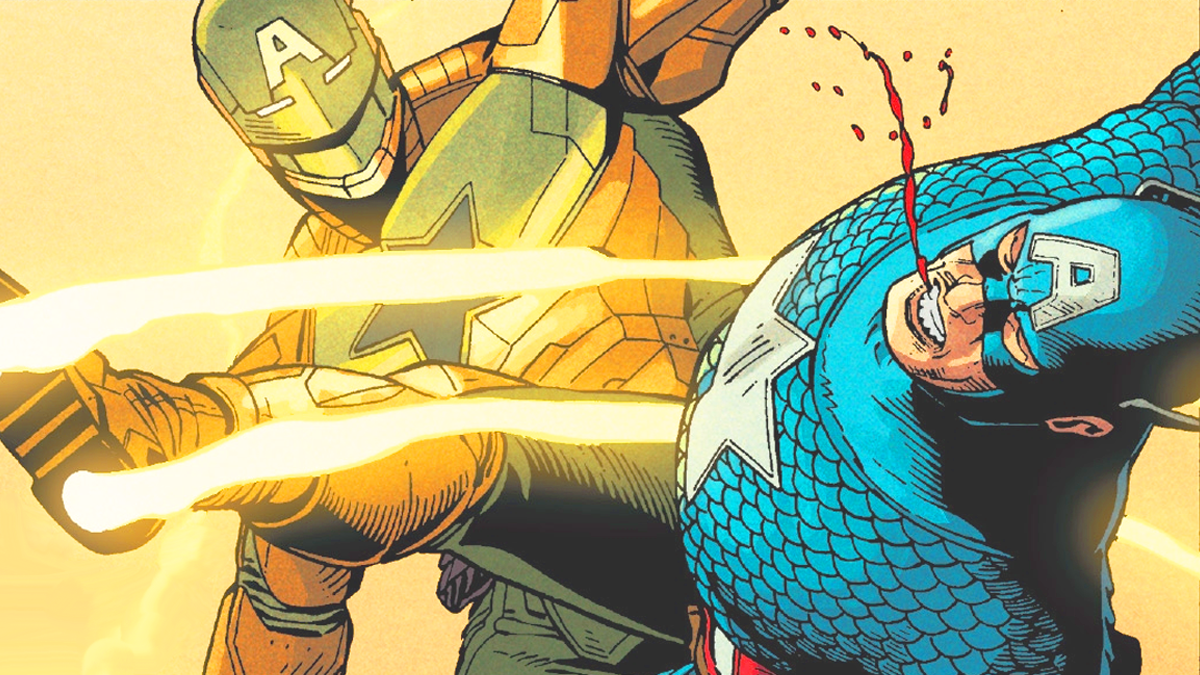Despite all the controversy, outrage, and general discourse surrounding the entire affair, Marvel Comics Executive Editor Tom Brevoort says that if he were ever given the chance to redo the infamous ‘Captain America is a secret Hydra agent’ reveal, he “wouldn’t do any of it differently.”
Hydra Cap attempts to negotiate a peaceful surrender from the Avengers in Secret Empire Vol. 1 #10 (2017), Marvel Comics. Words by Nick Spencer, art by Steve McNiven, Jay Leisten, Matthew Wilson, and Travis Lanham.
As previously reported, the topic of the controversial 2016 storyline was first brought to Brevoort’s recent attention on May 25th, when for that week’s edition of his Man With A Hat Substack blog’s regular ‘A Comic I Worked On That Came Out On This Date’ feature, he chose to offer his thoughts on its kick-off issue, Captain America: Steve Rogers Vol. 1 #1.
“Here comes trouble!” began the Marvel Comics editor. “[This issue] came out on May 25, 2016, marking the first time that Rogers picked up the identity of the Living Legend of World War II in a couple of years. But of course, all anybody remembers about this first issue is its final pages, in which the rejuvenated Rogers reveals that something is very wrong with him, as he reveals that he’s an operative working for Hydra.”
“If we were over-concerned about bringing back Bucky, we were perhaps under-concerned about the impact that this moment was going to have when it hit,” Brevoort recalled. “We knew it was going to cause controversy, that was pretty much the whole point. But fans went crazy, and not even just fans—this moment became the center of that culture wars, with any number of bad actors pointing at it as evidence of some manner of moral decay that had infected the entire industry.”
The Star-Spangled Avenger reveals himself to be an agent of Hydra in Captain America: Steve Rogers Vol. 1 #1 (2016), Marvel Comics. Words by Nick Spencer, art by Jesús Saíz and Joe Caramagna.
“Thing were serious enough that I received death threats for allowing this to happen—I had to cancel an appearance at that year’s Baltimore Comic Con due to a threat that was sent from the Baltimore area and that the police we consulted considered a legitimate threat and not just some blowhard spouting off,” he continued. “Fun times! The person who got hit the hardest was probably writer Nick Spencer, and most of those who were angry didn’t want to hear that this was the first move in a carefully-constructed storyline that was going to play out over the next 18 months or so.”
“It was a big, brassy story—maybe too big at certain points—and one that Nick almost lost control of at one point or another,” wrote Brevoort, wrapping up his reflection. “But ultimately, we were able to keep the whole thing together long enough to land the plane in a mostly-satisfying way in the Secret Empire crossover that came the following year. Lost in the crowd a little bit, but probably thankful for it in this instance, was artist Jesus Saiz, who turned in some seriously great artwork on this issue and those that followed.”
The Red Skull recalls his first battle with the titular hero in Captain America: Steve Rogers Vol. 1 #1 (2016), Marvel Comics. Words by Nick Spencer, art by Jesús Saíz and Joe Caramagna.
Having piqued his reader’s curiosity on the nearly-decade old storyline, Brevoort was asked by another reader, “Considering the controversy that surrounded the Captain America: Steve Rogers series, is there anything you would change with hindsight? Or do you feel the general premise of the story would get that kind of reaction no matter what?”
Presenting his answer in the latest edition of his Substack blog, the Marvel Comics editor asserted, “I think there was a specific confluence of events outside of the comic book industry that resulted in that reaction getting so much traction, so timing was a part of it. But also, there were plenty of people who were uninvolved in reading comics who decided that they needed to be outraged about those developments as part of their larger culture war battles.”
Hydra Cap rewrites the history of Earth-616 in Secret Empire Vol. 1 #10 (2017), Marvel Comics. Words by Nick Spencer, art by Steve McNiven, Jay Leisten, Matthew Wilson, and Travis Lanham.
“Those folks, I didn’t tend to pay a lot of attention to at all, as they were irrelevant to the sales of the series,” he then admitted. “So no, I wouldn’t do any of it any differently (except perhaps to find some way to deliver electric shocks to writer Nick Spencer so that he’d get his material done slightly earlier.)”
“No matter what you do, no matter what story you tell, there are going to be those who aren’t going to like it, and in order to do your best work, you can’t be cowed by what people might say about the work,” he ultimately concluded. “And almost a decade later, Captain America is still fine and well, so all of that agita was ultimately a tempest in a teapot anyway.”
Steve Rogers fights to take back America from Hydra control in Secret Empire Vol. 1 #10 (2017), Marvel Comics. Words by Nick Spencer, art by Steve McNiven, Jay Leisten, Matthew Wilson, and Travis Lanham.
Mentioned In This Article:Captain AmericaCaptain America: Steve RogersHydra Captain AmericaMarvelMarvel ComicsSteve RogersTom Brevoort
More About:Comic Books
Tom Brevoort says that for all the outrage and discourse it caused, he has no regrets about Captain America’s temporary Hydra heel turn. Read More

